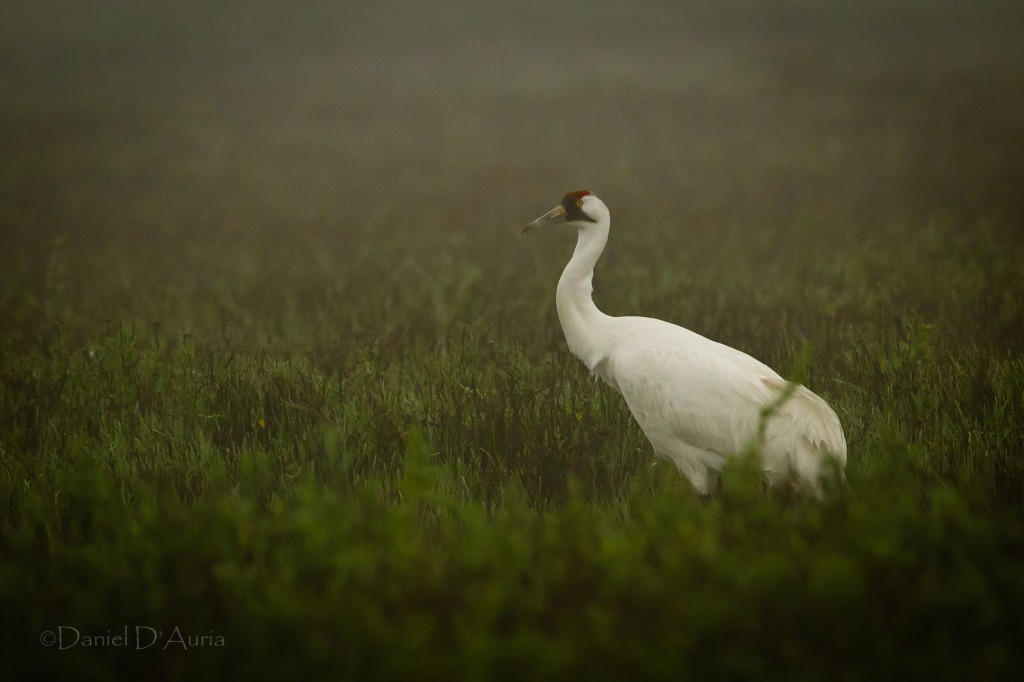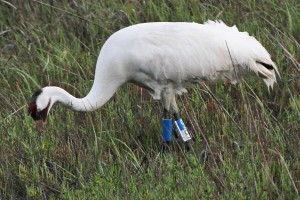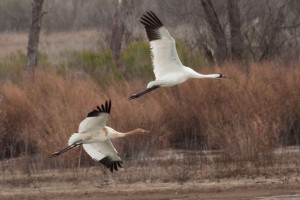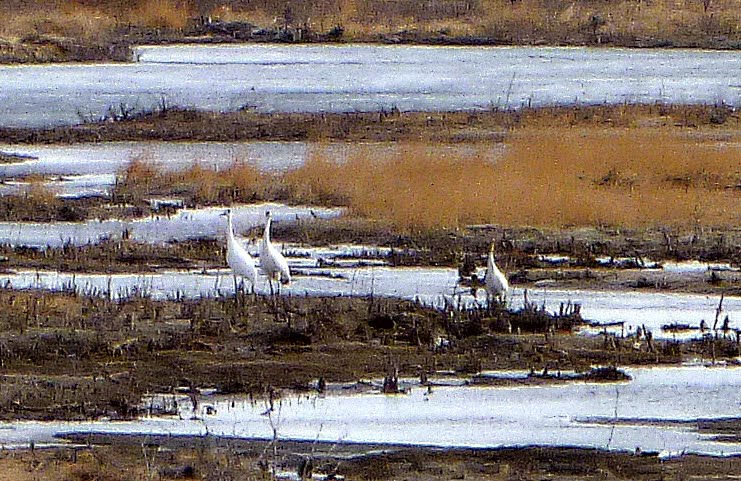Archive for the ‘Endangered Species’ Category
Whooping Crane Shot – $10,000 Reward
April 24, 2012by Chester McConnell, Whooping Crane Conservation Association
The Whooping Crane Conservation Association will pay a reward not to exceed $10,000 to anyone who provides information which leads to the conviction of any individuals responsible for the killing of a whooping crane which took place on the afternoon of Friday, April 20, 2012 along 354th Avenue, approximately 17 miles southwest of Miller, S.D. The purpose of the reward is to encourage the public to share information they might have about criminal activities involving whooping cranes. Federal, State, Provincial, and other public law enforcement personnel, and criminal accomplices who turn “states” evidence to avoid prosecution, shall not be eligible for this reward. If more than one informant is key to solving a specific case, the reward will be equally divided between the informants. 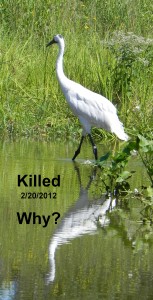
A reward has also been offered by the U.S. Fish and Wildlife Service for information leading to the arrest and conviction of the person responsible for the shooting of the whooping crane. Law enforcement officers from the Service and the South Dakota Game, Fish and Parks are investigating the shooting, which took place on the afternoon of Friday, April 20, 2012. The migrating adult whooping crane was traveling with two additional whooping cranes before being shot with a high-power rifle as it was standing in a corn field.
Anyone with information should call either the 24-hour “Turn in a Poacher Hotline” at 1-888-OVERBAG (683-7224) or the U.S. Fish & Wildlife Service at 605-224-9045 to report any information which will aid officers in the apprehension of the shooter. Callers can remain anonymous.
Eleven whooping cranes of the experimental Eastern Migratory population and non-migratory Louisiana population have been shot in the last two years. The Alabama case of January, a year ago, is still active. The Louisiana shootings have been solved by State Law Enforcement personnel and a reward will not be involved. One case is still active in Indiana. In Indiana the State has offered $2,500, the Fish and Wildlife Service $2,500 and the Humane Society $2,500 in reward.
Donations (which are tax-deductible) are being requested for the Whooping Crane Conservation Association’s Reward Account.
Donations should be mailed to Whooping Crane Conservation Association, 2139 Kennedy Avenue, Loveland, CO, USA 80538 or to donate by credit card click on the button below…
Thank You
Four Whooping Crane Flocks Thriving
April 21, 2012By: Chester McConnell, Whooping Crane Conservation Association
Western Whooping Crane Flock
“Only 5 whooping cranes remain on Aransas National Wildlife Refuge as of April 21” according to Dan Alonso, Refuge Manager. All others have begun their migration towards their nesting grounds at Wood Buffalo National Park, Canada. “Only 3 of the 29 whooping cranes carrying GPS transmitters remained on the refuge this past week” said Brad Strobel, Aransas Refuge biologist. Further north on the whooper migration route, Martha Tacha, U.S. Fish and Wildlife Service, reports that, “most of the cranes with GPS transmitters have now passed southern Nebraska and are continuing on their migration north. The cranes are currently distributed from northern Texas to northwestern Saskatchewan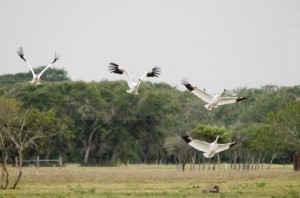 with some being within three days flying time of their Canadian nesting grounds. Some of the migrating whoopers were probably slowed last weekend due to the extensive strong storms from Oklahoma through South Dakota.”
with some being within three days flying time of their Canadian nesting grounds. Some of the migrating whoopers were probably slowed last weekend due to the extensive strong storms from Oklahoma through South Dakota.”
Further north on the migration route, wildlife technician Lea Craig-Moore, Canadian Wildlife Services reports that, “Whooping crane migration is in full swing in the Saskatchewan area.” She advised, “We have had the first flush of arrivals in the province and have birds spread from the SE prairie to the NW boreal. Family groups have been seen in a number of locations. Young cranes are learning the preferred stopover sites from their parents as they migrate.”
Eastern Whooping Crane Flock
Most of the whooping cranes in the eastern experimental flock have now reached their Wisconsin nesting area. Wisconsin Department of Natural Resources pilot Bev Paulan conducted an aerial survey April 17th and reported that there are currently 10 active nests located in the core reintroduction area in Wisconsin. Three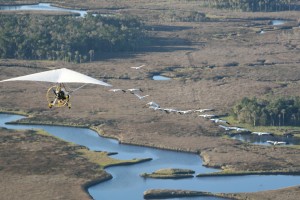 nests were abandoned earlier. Ten more pairs could possibly nest. Heather Ray, Operation Migration advises that “Hopes are high for baby chicks!”
nests were abandoned earlier. Ten more pairs could possibly nest. Heather Ray, Operation Migration advises that “Hopes are high for baby chicks!”
For several weeks, there has been much interest on the 9 young whooping cranes led south by Operation Migration ultralight planes to Alabama. Due, in part to government regulations, the young birds were finally placed on Wheeler National Wildlife Refuge in Alabama to spend the winter. On April 12 the 9 departed Alabama together on their first unaided journey north. They split into two or more groups during migration, and may be back in Wisconsin as you read this. Not quite a year old, the cranes are too young to pair up or breed. They will wander around the Wisconsin area nesting area and learn how to be whooping cranes.
Louisiana Non-Migratory Flock of Whooping Cranes
On December 1, 2011, a second cohort of juvenile whooping cranes was shipped to Louisiana from the Patuxent Wildlife Research Center. As with the first cohort, the 16 new birds (7 males, 9 females) were initially held in the top‐netted pen. Permanent bands and transmitters were attached to their legs on 8‐9 December and the birds were released into the open pen on 27 December.
On 31 December L4‐10, a survivor from the first cohort, returned to the pen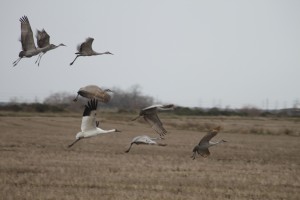 site and joined the 16 chicks. He had spent almost all summer and fall in the marsh just west of the release area and therefore had the strongest ties to the area. The 16 juveniles initially attempted to chase him away and while they continue to keep him away from the food shelter and the feeders they generally became more tolerant of his presence. Food continued to be provided for the birds in the open pen but will soon be discontinued.
site and joined the 16 chicks. He had spent almost all summer and fall in the marsh just west of the release area and therefore had the strongest ties to the area. The 16 juveniles initially attempted to chase him away and while they continue to keep him away from the food shelter and the feeders they generally became more tolerant of his presence. Food continued to be provided for the birds in the open pen but will soon be discontinued.
The young whoopers have shown a similar pattern of movement and pen use to the previous cohort – roosting outside the pen at night but using the pen during the day, primarily in the afternoons. However, with more water across the marsh this group of birds is beginning to range further away from the pen and use areas on the east side of the property which the first cohort did not use.
Florida Non-migratory Flock of Whooping Cranes
Marty Folk, Florida Fish and Wildlife Conservation Commission reports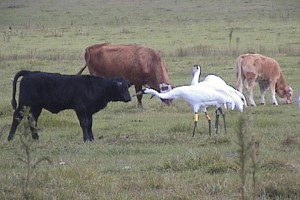 that, “As of 1 February 2012 we estimated there were 19 whooping cranes in the Florida resident population (8 males, 11 females) including 7 pairs. Again, this year, we will study the nesting ecology of these whooping cranes and Florida sandhill cranes. The goals are to determine causes of nest failure, compare the incubation behavior of the 2 species, and determine the efficacy of several research tools for these purposes. The nesting season has begun with our first sandhill crane nest just discovered in Polk County. Drought continues to plague Florida’s wetlands. The northern range of these cranes is very dry and unlikely to support much crane nesting. Fortunately, further south, we have some water for nesting.”
that, “As of 1 February 2012 we estimated there were 19 whooping cranes in the Florida resident population (8 males, 11 females) including 7 pairs. Again, this year, we will study the nesting ecology of these whooping cranes and Florida sandhill cranes. The goals are to determine causes of nest failure, compare the incubation behavior of the 2 species, and determine the efficacy of several research tools for these purposes. The nesting season has begun with our first sandhill crane nest just discovered in Polk County. Drought continues to plague Florida’s wetlands. The northern range of these cranes is very dry and unlikely to support much crane nesting. Fortunately, further south, we have some water for nesting.”
Whooping Cranes Begin Migration to Canada
April 12, 2012An estimated 115 whooping cranes remain on, or near the Aransas National Wildlife Refuge in Texas according the U.S. Fish and Wildlife Service. Aransas Refuge officials report that, “Data from GPS-marked whooping cranes also indicates many of the birds have begun their migration. Approximately two thirds of the marked birds have left the Texas coast. Departure dates for those cranes in migration range between the 5th of March and 10th of April with 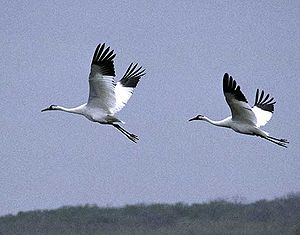 an average departure date of 29 March. To date, none of the marked birds have arrived at Wood-Buffalo National Park. We continue to download data from the radio-marked birds, as well as receive information from actual sightings.”
an average departure date of 29 March. To date, none of the marked birds have arrived at Wood-Buffalo National Park. We continue to download data from the radio-marked birds, as well as receive information from actual sightings.”
Reports of whooping crane sightings made to the Whooping Crane Conservation Association indicate migrating birds are in every U.S. state and Canada along the migration route. The migration appears to be earlier this year and may be due to the warmer weather. Hopefully the nesting grounds at Wood Buffalo National Park, Canada will be in suitable condition when the whoopers arrive there. here.
For those whoopers currently remaining on Aransas Refuge, habitat conditions appear to be improving. Aransas personnel report that, “As of April 11, the monthly precipitation totals for Aransas National Wildlife Refuge are 1.19 inches. Salinity levels in San Antonio Bay continue to remain under 20 parts per thousand (ppt) and are currently recorded at 16.5 ppt. Increased precipitation and fresh water inflows from Central Texas are helping to improve conditions in the marsh but the refuge is still not to pre-drought conditions.”
Remote Tracking of Aransas-Wood Buffalo Whooping Cranes
April 10, 2012By: Aaron Pearse, USGS Northern Prairie Wildlife Research Center and Brad Strobel, USFWS, Aransas Wildlife Refuge
Since 2009, a partnership of agencies and organizations has been conducting research on the Aransas‐Wood Buffalo population of Whooping Cranes. Fundamental objectives of our research efforts are: 1) to advance knowledge of Whooping Crane breeding, wintering, and migratory ecology, including threats to survival and population persistence; 2) to disseminate research findings in reports, presentations, and peer‐reviewed literature to provide reliable scientific knowledge for conservation, management, and recovery of Whooping Cranes; and 3) to minimize negative effects of research activities to Whooping Cranes.
Funds and personnel in support of this endeavor are being contributed by the Canadian Wildlife Service, The Crane Trust, Plate River Recovery Implementation Program, U.S. Fish and Wildlife Service, U.S. Geological Survey, Parks Canada, International Crane Foundation, and Gulf Coast Bird Observatory.
To meet objectives, members of the partnership have captured and marked 35 Whooping Cranes. We captured one juvenile and two adults along the Gulf Coast of Texas during winters 2009 and 2010. Capture teams marked nine juveniles during August 2010 and 12 juveniles during August 2011 at Wood Buffalo National Park in Canada. In December 2011, we successfully captured and marked 11 cranes on Aransas National Wildlife Refuge, eight of which were known or suspected paired adults.
Capture teams consist of individuals with experience handling and marking endangered cranes. At capture, a licensed veterinarian performs a health check on each crane, which includes an external examination and screenings for pathogens, toxins, and parasites. We affix all captured cranes with a satellite transmitter (Platform Transmitting Terminal) with Global Positioning System capabilities mounted on a two‐piece leg band. The transmitter and leg band weigh approximately 72 g, which is <1.5% of body weight of adult cranes.
Integrated solar panels on all exposed surfaces allow transmitters to function for approximately three to five years. Transmitters record GPS locations every six hours, providing detailed information on nocturnal and diurnal site use and general flight paths.
Approximately every 56 hours, transmitters upload new data, which assists in identifying mortality events when possible.
We have been collecting location data on marked birds since December 2009 and expect data collection to continue for at least the next three years. As our sample of marked cranes has expanded in 2011, expectation among research partners has increased as we begin to explore the volume of rich information provided by marked individuals. Partners agree that this opportunity to mark wild Whooping Cranes with GPS technology represents an exceptional prospect to enhance our understanding of whooping Cranes and assess risks they face during their entire life cycle.
Article from The Unison Call, newsletter of the North American Crane Working Group
Non-Migratory Whooping Cranes -Louisiana Update
April 7, 2012Louisiana Whooping Cranes – February 2012
By: Sara Zimorski, Louisiana Department of Wildlife and Fisheries.
2010 Cohort
After dispersing away from the release pen most of the birds from this group of 10 left the marsh and moved north into agricultural areas, primarily rice and crawfish. As previously reported 1 bird became sick and was euthanized, 1 bird was likely killed by a predator, and a third bird disappeared and is presumed dead.
Summer research of the remaining 7 focused on evaluating the habitat chosen by the birds. In early October, 2 birds in a group of 3 were shot and killed by a pair of teenage boys. An eyewitness reported the shooting and state law enforcement agents were able to apprehend the suspects and move forward with pressing charges. The case will be going to court in the very near future. The third bird’s transmitter failed and she disappeared at the same time the others were shot. With no additional data or sightings she is missing and presumed dead and foul play is suspected to be a factor in her disappearance. As a result of the shooting incident the Louisiana Department of Wildlife and Fisheries has stepped up our outreach and education efforts, including working to develop Whooping Crane‐related lesson plans and curriculums that will be incorporated into public school classes for middle and high school students.
Unfortunately in late November an additional bird was killed, likely by a predator, reducing the 2010 cohort to only 3 survivors. The 3 survivors remain separate from each other with 2 remaining in agricultural areas and the third returning to the pen and joining the new group of chicks.
2011 Cohort
On 1 December 2011, a second cohort of birds was shipped to Louisiana from the Patuxent Wildlife Research Center. As with the first cohort, the 16 new birds (7 males, 9 females) were initially held in the top‐netted pen. Permanent bands and transmitters were attached to their legs on 8‐9 December and the birds were released into the open pen on 27 December.
On 31 December L4‐10, a survivor from the first cohort, returned to the pen site and joined the 16 chicks. He had spent almost all summer and fall in the marsh just west of the release area and therefore had the strongest ties to the area. The 16 juveniles initially attempted to chase him away and while they continue to keep him away from the food shelter and the feeders they have generally become more tolerant of his presence. Food continues to be provided for the birds in the open pen but will be discontinued in the next few weeks.
The birds have shown a similar pattern of movement and pen use to the previous cohort – roosting outside the pen at night but using the pen during the day, primarily in the afternoons. However, with more water across the marsh this group of birds is beginning to range further away from the pen and use areas on the east side of the property which the first cohort did not use.
On 4 January, chick L14‐11 was handled to replace the original transmitter she had been given which was not functioning properly and during this time she apparently suffered an injury that left her unable to fly. On 19 January she was brought to the LSU vet school for evaluation and radiographs revealed a fractured leg coracoid bone. In order to give her the best chance of recovering the ability to fly and be released in Louisiana, surgery was performed on 27 January.
Surgeons at the vet school realigned the ends of the fractured bone and attached a small metal plate to stabilize the site. Her recovery is going well thus far and we are hopeful she will soon be able to fly again so she can live in the wild in LA with the rest of the cohort.
Unfortunately one chick, L12‐11, disappeared on 3 February. With no data from his transmitter and no sightings since then he is believed to be dead. As of 17 February, 18 (8 males, 10 females) birds remain alive in LA.
Article from The Unison Call, newsletter of the North American Crane Working Group
“Lobstick” Worlds Oldest Whooping Crane
March 30, 2012Tom Stehn, retired Chair of the International Whooping Crane Recovery Team has authored a captioned slide show about “Lobstick” the whooping crane. Lobstick is believed to be the oldest whooping crane in the world. He will be 34 years old this June. Lobstick, a male, is a member of the Aransas-Wood Buffalo whooping crane population. He has often been in the news concerning his role as a whooper parent and during his migratory flights from his Canada nesting habitat to the Texas wintering area.
To view the slide show, please visit “Journey North’s” outstanding educational web site. Click this link to see photos and read Lobstick’s astonishing story.
Aransas National Wildlife Refuge Update
March 29, 2012Aransas National Wildlife Refuge, U.S. Fish and Wildlife Service issued a report today describing the status of the whooping crane population on the refuge, water conditions and habitat improvements. Some whooping cranes have already started their migration north towards their nesting area at Buffalo National Park, Canada. Click on the following ling for the full report:
Aransas Refuge Estimates 245 Whooping Cranes
February 17, 2012By Chester McConnell, WCCA
Aransas National Wildlife Refuge biologists now estimate the population of whooping cranes to be approximately 245 individuals within their survey area. This number does not include whoopers known to be in at least five other Texas counties and other states. Some of the birds are moving around off the refuge for reasons not fully understood. It is believed that the whoopers may be seeking additional food sources. The refuge’s January 2012 survey consisted of three flights conducted on January 26, 27, and 29th. Survey biologists searched Matagorda Island, San Jose Island, Blackjack Peninsula, Lamar Peninsula, Dewberry Island and Welder Flats. A second round of survey flights will take place in mid to late February.
Biologists are receiving many reports of whooping cranes outside the survey area in the following Texas counties: Matagorda, Refugio, Calhoun, Aransas, Williamson, San Patricio, Maverick, and Caldwell. Whooping cranes of the Aransas-Wood Buffalo population are also currently residing in other states as far north as Nebraska. These cranes are naturally supplementing their own food sources by wintering around freshwater lakes and other marshes.
Refuge personnel continue to help alleviate low food resources by doing more prescribed burns. This winter they have burned 8,095 acres of habitat. Whooping cranes have been observed eating the roasted acorns and other food sources in burned areas. An additional 6,129 acres are planned to be burned while whooping crane remain on their winter habitat
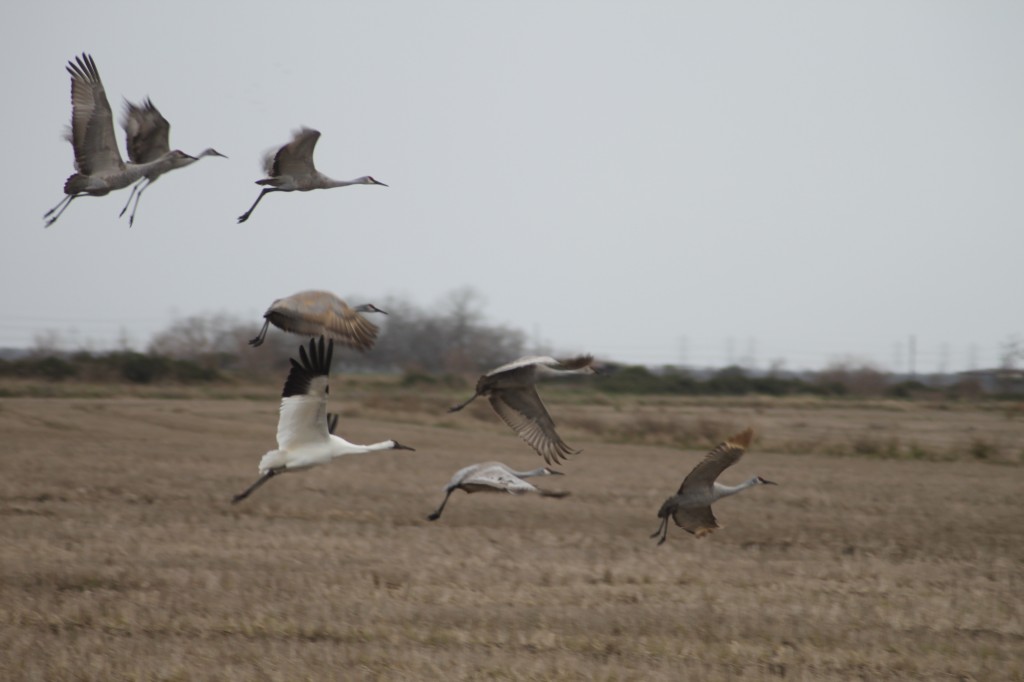
- Whooping crane with sandhill cranes in Texas rice field. Photo by Leanne Sliva
Fortunately some rains have fallen of Aransas Refuge recently. The first two weeks of February produced a total of 1.89 inches of rain. Water salinity levels have dropped due to recent freshwater inflows from rain in Central Texas, as well as localized rainfall. Salinity levels in San Antonio Bay are currently recorded as 19.9 parts per thousand. Salinity levels in surrounding bays still remain higher than normal which forces whooping cranes to expend more energy flying to fresh water sources.
Methods of counting whooping cranes on Aransas Refuge have been modified. Refuge official, Vicki Muller explained: “In previous years, the refuge gauged the whooping crane population by counting individual birds within the survey area. The aerial surveys objective was focused on counting every individual bird regardless of where they were located within the survey area. This technique is no longer feasible because the population is increasing. Biologists are flying along a transect, straight lines set at specific distances within the survey area. Previously each survey consisted of a single flight; now one survey includes three flights on three separate days (weather permitting) within a preset timeframe. The birds counted represent an estimate of the population within the surveyed area. It is expected that some birds will be not be included in the count, but this method (known as Distance Sampling) is commonly used to determine rare and endangered wildlife populations, including fin whales, Karner blue butterflies, and raptors.”
Aransas officials explain that, “Over the years the whooping crane population has been growing, the habitat changing, and the birds naturally dispersing. The primary goal is to ensure the recovery of the species and to do that the refuge and its partners must adjust with the ever-changing conditions. In 2009, biologists began putting radio telemetry bands on the cranes. Using leg snares, and other trapping techniques, the birds are captured and equipped with GPS leg bands. This technology records birds locations and allows biologists to learn which habitats they are using, where they stop during their migration, and much more. This technology is extremely valuable but it will be several years before sufficient data from the individual birds can be collected and fully analyzed. It will take a considerable more amount of time before the data will reflect patterns of the population as a whole. To date, the refuge and its partners are tracking approximately 30 whooping cranes with leg bands.”
Citizens Help Monitor Whooping Cranes
January 30, 2012by Chester McConnell, Whooping Crane Conservation Association
Excitement is rampant in many thousands of bird watchers when whooping cranes begin their migration from Buffalo National Park, Canada southward to Aransas National Wildlife Refuge, Texas. Birders get a high when they are lucky enough to spot an endangered whooping crane and add it to their life list of birds observed. To many it is the “crown jewel” of their observations. Such spotting’s are discussed at ornithology meetings, boasted about at cocktail parties and even announced at church. “Really, we are fortunate when blessed with seeing one of the approximate 300 whoopers in the last remaining wild flock” said Dorothy McConnell, Daphne, AL. Dorothy and her husband have traveled all along the 2,500 mile migration route to watch whoopers and other birds.
Many birders take their whooping crane sightings one step more. They report their observations on the Whooping Crane Conservation Association’s web site at https://whoopingcrane.com/report-a-sighting/ . The Association analyzes the reports, plots the sightings on a map and sends the reports to officials in the U.S. Fish and Wildlife Service. Reports are forwarded to either of two Service offices depending on whether the whoopers were spotted west or east of the Mississippi River. The reports by citizens are used by the Fish and Wildlife Service along with reports from its own team of federal and state spotters.
Western sightings are primarily from the Aransas-Wood Buffalo flock with a few from the non-migratory experimental flock in Louisiana. Most the eastern sightings are from the Wisconsin-Florida experimental flock or the non-migratory Florida flock. The Whooping Crane Conservation Association received approximately 150 reports from citizens during the past five months. All of the reports are evaluated and assist the federal officials in their monitoring responsibilities.
Reports start arriving to the Association soon after the whoopers depart from Wood Buffalo NP. Approximately 15 reports were received from Canada during September and October. A month later reports arrived from North Dakota, Nebraska, Kansas and Oklahoma. Most of the recent reports have been from Texas. Just this morning Jorjanna Price sent a report of three whoopers in a pasture in Refugio County, TX. This sighting was near Aransas Refuge, winter home of whooping cranes. Other reports came from Rebecca Alderson of two adult whoopers in south central Kansas; Rob Vinson spotted one adult bird in southeast Missouri; two other reports from Tracy Wisenburg of six whoopers and Byron Stone of three, both in Granger Lake, Texas; eight birds were reported at Thorndale, Texas by Nadine French; Chris Flannigan spotted two adult birds near Seadrift, Texas; and Darren Schlessinger observed three (2 adults and 1 young) north of Austin in Stillhouse Hollow Lake, Texas.
The Association has received some unusual reports. Several birders reported five whooping cranes on private lands near the Quivira National Wildlife Refuge and Cheynne Bottoms State Wildlife Area in south central Kansas. These birds have been detected there since December 2011. Dan Severson, Quivira’s Refuge Manager believes that due to the mild winter and plenty of food, these birds may just remain in the area all winter rather that migrating to Aransas Refuge as usual.
The most unusual report that Whooping Crane Conservation Association has received was last week from Bill Riggs, Nebraska. Bill reports that he observed three whooping cranes (two adults and one juvenile) in the Platte River vicinity. Bill told the Association that, “I was driving along and spotted the birds a little before noon. They were
still there when I came back the same route. I’ve been blessed to see whooping cranes several times, a few times one was traveling with the Sandhills. But usually I see them after they’ve (whoopers) already headed on north. The whoopers seem more inclined to wait for warmer weather, around mid-April to start their own journey back north. If I hadn’t seen these myself, I wouldn’t have believed this. I first thought maybe they could have been Great or Snowy Egrets; I’ve seen both out there, but these look like Whoopers, two adults and one juvenile, slightly smaller with just a bit of rusty color left from the neck up.” On a return trip to the site, the whoopers could not be located.
Texas Climate News article – climate effects on whooping cranes
January 21, 2012
 The whooping crane – the tallest bird in North America and one of the rarest – is the leading symbol of wildlife-conservation efforts in the United States. In 1941, the species’ total population had dwindled to 15 cranes, discovered wintering on the Texas coast. The American Birding Association reported a species population of 599 last September, including 278 cranes in the group that migrates 2,500 miles between nesting grounds in Canada’s Wood Buffalo National Park and wintering habitat around Texas’ San Antonio Bay, north of Corpus Christi.
The whooping crane – the tallest bird in North America and one of the rarest – is the leading symbol of wildlife-conservation efforts in the United States. In 1941, the species’ total population had dwindled to 15 cranes, discovered wintering on the Texas coast. The American Birding Association reported a species population of 599 last September, including 278 cranes in the group that migrates 2,500 miles between nesting grounds in Canada’s Wood Buffalo National Park and wintering habitat around Texas’ San Antonio Bay, north of Corpus Christi.